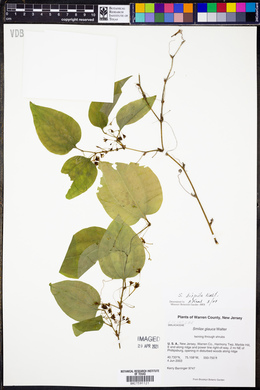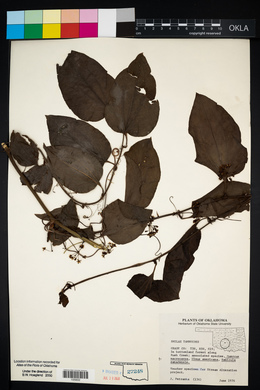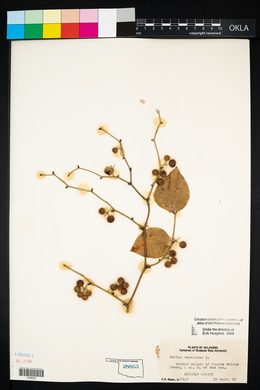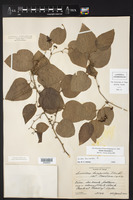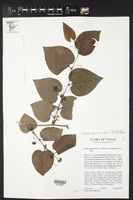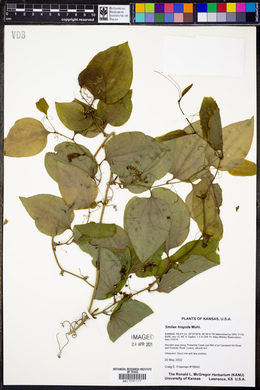Smilax tamnoides
|
|
|
|
Family: Smilacaceae
Chinaroot, more...Chinaroot, Bristly Greenbrier
[Smilax grandifolia, moreSmilax hispida Muhl. ex Torr., Smilax hispida var. australis Small, Smilax hispida var. montana Coker] |
Vines; rhizomes knotty, short. Stems perennial, climbing, branching, terete, to 7+ m × 9 mm, woody, glabrous, with prickles proximally, prickles usually absent distally; prickles blackish, unequal, 3-10+ mm, bristly, flexible. Leaves ± persistent in southern part of range, deciduous in north; petiole 1-2 cm; blade green, drying to light olive-gray, ovate-lanceolate, ovate, or sometimes pandurate, prominently reticulate, thin, 5-13 × 3-10 cm, not glaucous, glabrous (to prickly on major veins abaxially), base rounded to cordate, margins entire apically, minutely serrulate basally, thin, flat, not banded, not lobed, apex pointed. Umbels many, axillary to leaves, to 25-flowered, open to dense, spherical; peduncle often drooping, 1.5-6.5 cm. Flowers: perianth green to bronze; tepals 4-5 mm; anthers ± equaling to shorter than filaments; ovule 1 per locule; pedicel 0.4-1.2 cm. Berries black, globose, 6-10 mm, not glaucous. Flowering May--Jun. Wet to dry woods, thickets, bottomlands; 0--400 m; Ont.; Ala., Ark., Conn., Del., D.C., Fla., Ga., Ill., Ind., Iowa, Kans., Ky., La., Md., Mass., Mich., Minn., Miss., Mo., Nebr., N.J., N.Y., N.C., Ohio, Okla., Pa., S.C., S.Dak., Tenn., Tex., Vt., Va., W.Va., Wis. Smilax tamnoides is marked by its dark, flexible, and unequal bristles and leaves with minutely serrulate margins basally. The far-western S. californica appears to be closely related but lacks the serrulate margins of the leaf bases.
Perennial woody vine to over 7 m tall Stem: climbing, branching, hairless, with black needle-like prickles. Leaves: alternate, stalked, shiny green, 5 - 13 cm long, 3 - 10 cm wide, egg-shaped to broad lance-shaped or nearly round with a rounded to heart-shaped or squared base and a pointed to rounded tip often having an abrupt point (cusp), minutely toothed near base (10x magnification required), with five to seven major veins, hairless or prickly along the interconnecting veins beneath. Flowers: either male or female, found on separate plants (dioecious), borne on an inflorescence with branches radiating from a common point (umbel). The many open to dense umbels are borne axillary to the leaves, each being 1.5 - 6.5 cm across, spherical, and having up to 25 flowers with six green to bronze tepals 4 - 5 mm long. Fruit: a black berry, 6 - 10 mm across, spherical, with one or two seeds. Tendrils: in leaf axils. Similar species: Smilax rotundifolia and Smilax hispida are vines with woody stems. Smilax rotundifolia differs from S. hipida by having stout flattened prickles and two- to three-seeded fruit covered in a whitish waxy coating (glaucous). Flowering: late May to early June Habitat and ecology: Frequent in woods, shaded floodplains, and rich dune slopes. Occurence in the Chicago region: native Smilax is the ancient Greek name of an evergreen oak. Hispida means stiff-haired.Author: The Morton Arboretum Slender woody vine, often climbing high, beset (at least below) with unequal needle-like prickles; lvs deciduous, shiny-green, ovate to rotund; 8-12 נ6-10 cm at maturity; acute to rounded or cuspidate; at base rounded to truncate or cordate, not thickened at the margin, minutely serrulate (visibly so at 10ש, 5- or 7-nerved, the reticulate veinlets not much elevated; peduncles flattened, mostly 2-6 cm, generally at least twice as long as the subtending petiole; fr black, not glaucous, 6-8 mm, with 1(2) seeds; 2n=32. Moist woods and thickets; Conn. and N.Y. to n. Fla., w. to Mich., s. Minn., Nebr., and Tex., the commonest greenbrier in the w. part of our range. May, June. (S. pseudochina, misapplied; S. tamnoides, perhaps misapplied) Gleason, Henry A. & Cronquist, Arthur J. 1991. Manual of vascular plants of northeastern United States and adjacent Canada. lxxv + 910 pp. ©The New York Botanical Garden. All rights reserved. Used by permission. From Flora of Indiana (1940) by Charles C. Deam An infrequent species throughout the state. It prefers a moist, rich soil. …… Indiana Coefficient of Conservatism: C = 3 Wetland Indicator Status: FAC Diagnostic Traits: woody at base; prickles black and flexible; tendrils present; leaves serrulate towards base, the lower surface green; peduncles >2 cm (>1.5× longer than petiole); fruits not glaucous, mostly 1-seeded. |
|
|
|


































